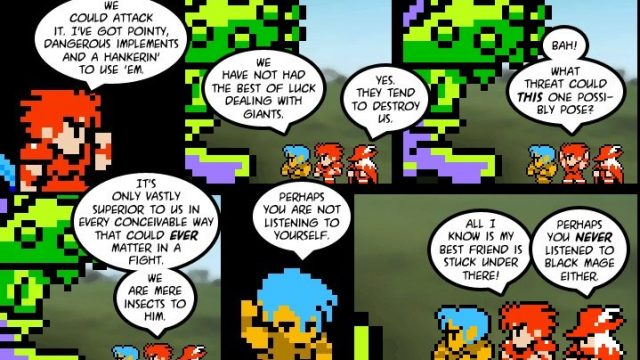“See how the grass is stamped down here and here?”
“Yes.”
“That indicates they were having an argument.”
“You can really tell that just from their tracks?”
“No. But you have to admit, I’m probably right.”
Brian Clevinger’s 8 Bit Theater (2001-2010) was a strange beast in a lot of ways. As the second sprite comic (beaten by Bob and George, which began a year earlier), it was a tremendous influence within the webcomic scene, spawning an entire genre of comics created with sprites from old video games. Like punk rock before it, it was attractive to young wannabes because it looked easy – copy and paste, stick in some word balloons. But like punk rock before it, what the wannabes missed was the level of craft holding the whole thing together, on both a writing and visual level (Johnny Ramone would be the punk rock equivalent here).
8 Bit Theater is a parody of (and uses the sprites from) the 1987 Square Enix game Final Fantasy. Four men, each named after their job – Black Mage, Fighter, Red Mage, and Thief – join together to form the Light Warriors, a heroic band sent out on a quest with implications they were destined to save the world. Knowledge of Final Fantasy is unnecessary; the original story beats are naturally weaved in as setup for jokes. Like many of the greatest comedies – like Blackadder or Arrested Development – 8BT is focused on one goal, to the exclusion of all others: telling jokes. Sincere emotion, thematic statements, complex characterisation; none of these things factor into the comic’s thought process at all, unless they can set up a joke. The most famous aspect of the comic is the painfully slow plotting, which is only true if you consider ‘pulling genre levers’ to be plotting. The reason characters don’t tend to get through the whole ‘saving the princess and moving on to the next quest’ thing is because the characters are constantly backstabbing, undermining, humiliating, and otherwise irritating each other, which tends to slow them down.
“What did I ever do to deserve this as my fate? Other than all the sinning.”
That dedication to a single goal makes the comic remarkably consistent – it’s about twenty or thirty strips in that Clevinger gets into a groove, understanding his character’s main motivations and his setup-punchline process, and from there he uses both to create increasingly ridiculous and hilarious chains of logic; it’s only towards the end, nearly six years and 980 strips in, that it starts to waver before finding its feet again for the ending (I think you can feel his creative exhaustion – once we’re definitely in the ending, it’s like he finds his enthusiasm again). The language of the comic is needlessly formal and precise; you can feel that it’s written by a guy who loves debating with people on the internet even when the characters don’t literally descend into needlessly tangential debate. The comedic structure means this attitude isn’t just tolerable, it thrives; the characters continuously attempt to control their world with language and, if they don’t outright fail, often reveal their own insecurity or laziness (“Your point or points may or may not have been excellent, but I must disagree on the basis that I’m sure it involves me doing things I’d rather not.”), and it’s always funny.
“My plans are always practical! It’s the laws of physics that get in the way of my success.”
It also means that the comic becomes something totally visually unique. At first, it really is an ugly copy-paste, but just as with the language, Clevinger settles into a simple groove, filtering photographs and using them as backgrounds in a non-distracting way and finding methods of breaking up the monotony that don’t draw attention to themselves (in that featured image, you can see him make a ‘panel’ by putting an individual character in black space, a simple recurring trick). And again, his visual tricks and photo manipulation become more audacious and detailed; at the end, when the characters have ascended to godhood and are fighting in a hellish alternate dimension, it achieves a level of grandeur that only makes the ugly 8-bit character sprites even funnier.
If there’s any single lesson to be learned from this (aside from ‘read 8 Bit Theater, you bastards’), it’s the value of aiming for simple artistic goals. Clevinger aims to write a funny script, and creates classic absurdity; he aims to copy and paste in Photoshop, and creates beauty; he writes Black Mage as chasing evil, and creates a comic foil that is, himself, a pure ball of insecure rage. I recommend 8 Bit Theater because through that simple set of goals, Clevinger managed to create something totally unique and yet recognisably hilarious.
“That’s wrong on more levels than I can count, and they’re both pretty basic levels too.”

